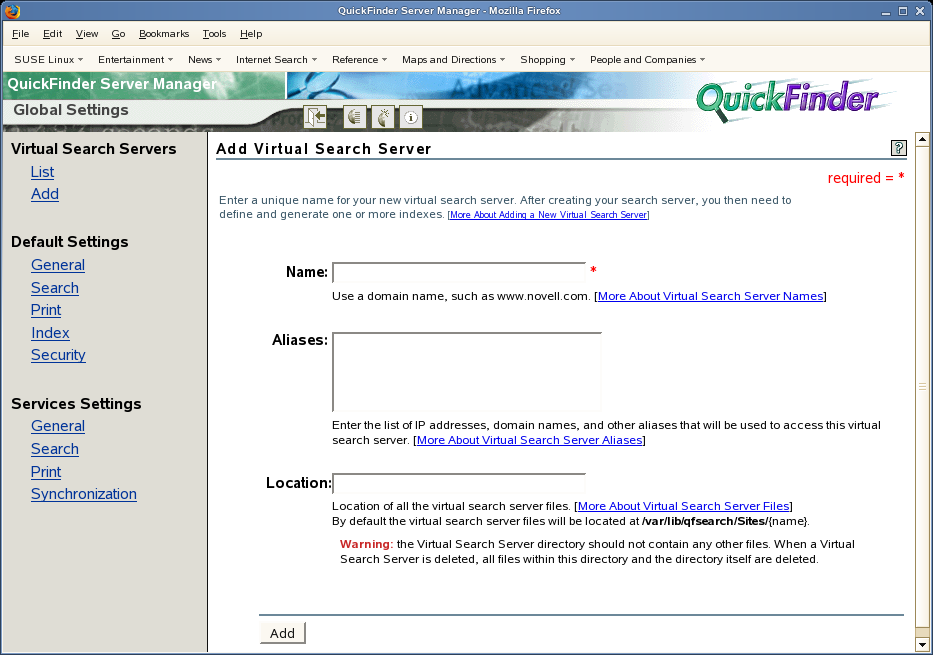8.2 Creating Virtual Search Servers
After you have carefully planned your search service, you can start creating and configuring virtual search servers and begin adding indexes to them.
8.2.1 Creating a Virtual Search Server
-
On the QuickFinder Server Manager Global Settings page, click .
-
In the field, specify a new virtual search server name, which is typically the DNS or domain name of your server.

For more information about virtual search server names, see Naming a Virtual Search Server.
-
In the field, specify a virtual search server alias, which is typically the IP address of your server, the domain name, and any other alias that can be used to access this virtual search server.
See Using the Virtual Search Server Alias for more information about aliases.
-
In the field, specify the path where you want the index and configuration files to be stored.
If this field is left blank, QuickFinder stores the virtual search server files in the /searchroot/sites/sitename directory. Also, you can store the files on any volume on the server where QuickFinder is installed, but not on other servers.
-
Click .
8.2.2 Naming a Virtual Search Server
When a user sends a search query to the QuickFinder Server, QuickFinder determines which of all of your virtual search servers it should use to handle the incoming search request.
QuickFinder uses two methods for determining this:
-
Matching the domain name of the search query with the virtual search server names available in QuickFinder
-
Using the server=searchsitename query parameter to find matching virtual search server names
For example, in the following search request, QuickFinder uses the domain name search.domainname1.com as the name of the virtual search server:
http://search.domainname1.com/qfsearch/SearchServlet?query=find+something
This approach requires your server to be set up to recognize the domain name search.domainname1.com. Most servers can be set up to recognize and service multiple domain names in both software and hardware virtual server configurations.
You could also use an IP address to designate the virtual search server. For multiple virtual search servers, this approach works only in a hardware virtual server configuration where each virtual search server has its own unique IP address.
Using One DNS Name to Host Multiple Virtual Search Servers
If you are hosting a search service for two or more customers, you can name each virtual search server according to the organization or company name of each customer and then use the &server query parameter when handling search queries. One of the advantages of using the &server query parameter is that it allows you to use a single DNS name.
For example, suppose your server’s URL was searchit.novell.com. If you were setting up search services for a company called Digital Airlines and another company called DemoCity, you could host both services on your single server and then simply include the &server=digitalairlines and &server=democity query parameters within the search forms found on www.digitalairlines.com and www.democity.com.
Queries would be sent from the search forms on each Web site to the URLs corresponding to each virtual search server, as in the following example:
http://searchit.novell.com/qfsearch/SearchServlet?server=digitalairlines
and
http://searchit.novell.com/qfsearch/SearchServlet?server=democity
8.2.3 Using the Virtual Search Server Alias
When defining a virtual search server, you are required to give it a name. However, you can also define an alias that can be used when identifying a specific virtual search server during a search request.
An alias name typically follows one of two conventions:
-
An IP address.
This could be used either in the domain name portion of a URL or be included in a search query using the &server query parameter. Using an IP address in place of a domain name to select a virtual search server works only in a hardware virtual server configuration where each search server has its own unique IP address.
-
Any other numeric or textual value that can be passed as the value of the &server query parameter.
For most virtual search servers, the best choice for a search server name and alias is the Web server’s domain name and IP address.
8.2.4 Storing Virtual Search Server Files
Search server files include a set of index and configuration files for each virtual search server. When you create a new virtual search server, you can specify where you want virtual search server files to be stored, or you can accept the default path, which is determined by where you installed the QuickFinder Server.
Virtual search server files can be stored on any volume visible to the server that QuickFinder is installed on, regardless of which volume your QuickFinder Server is installed on. This includes SAN storage device volumes.